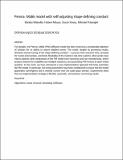| dc.description.abstract | For decades, the Perona–Malik (PM) diffusion model has been receiving a considerable attention of scholars for its ability to restore detailed scenes. The model, despite its promising results, demands manual tuning of the shape-defining constant—a process that consumes time, prompts for human intervention, and limits flexibility of the model in real-time systems. Most works have tried to address other weaknesses of the PM model (non-convexity and non-monotonicity, which produce chances for instability and multiple solutions), but automating PM remains an open-ended question. In this work, we have introduced a new implementation approach that fully automates the PM model. In particular, the tuning parameters have been conditioned to ensure that the model guarantees convergence and is entirely convex over the scale-space domain. Experiments show that our implementation strategy is flexible, automatic, and achieves convincing results. | en_US |

